
 |
||||||
|
GAY
FILM REVIEWS BY MICHAEL D. KLEMM
|
||||||
|
High Art Universal
Home Video,
Director/Screenplay Starring: Rated R, 101 minutes |
Through
A Lens Darkly
Lesbians, the Manhattan art scene and heroin are the ingredients of High Art, a superb feature film debut from 1998, written and directed by Lisa Cholodenko (Laurel Canyon). Radha Mitchell stars as Syd, a young woman who works at an art magazine called Frame. Though she has just been promoted to Assistant Editor, her newfound status still entails doing the grunt work and getting coffee for her superiors. Her live-in boy friend, James (Gabriel Mitchell), complains that they continue to treat her like an intern, and this sparks friction between them. |
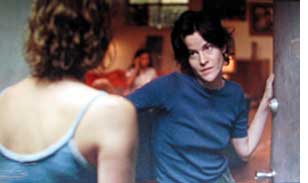 A
chance meeting with the upstairs neighbors, in reaction to water dripping
from the bathroom ceiling, sets the plot in motion. Syd meets Lucy (Ally
Sheedy), her partner Greta (Patricia
Clarkson), and an entourage stoned on heroin. Syd is impressed by Lucy's
photographs that hang all over the apartment. On a second visit, Syd tells
Lucy that she would like to submit her work to the senior editors at Frame.
Syd recognizes her raw talent and she sees this as the ticket to impressing
her bosses. A
chance meeting with the upstairs neighbors, in reaction to water dripping
from the bathroom ceiling, sets the plot in motion. Syd meets Lucy (Ally
Sheedy), her partner Greta (Patricia
Clarkson), and an entourage stoned on heroin. Syd is impressed by Lucy's
photographs that hang all over the apartment. On a second visit, Syd tells
Lucy that she would like to submit her work to the senior editors at Frame.
Syd recognizes her raw talent and she sees this as the ticket to impressing
her bosses. |
|
|
|
|
 Functioning
as a catalyst for drama, and disaster, is Lucy's girlfriend. Greta is a
washed up German actress who once worked with Fassbinder
but apparently hasn't appeared in films since. She constantly rehashes past
glories and drops the late director's name whenever she can. (She was supposed
to be in Berlin Alexanderplatz "but Hannah got the part instead.")
Greta is also a major league heroin addict and she is - rightly,
as it turns out - threatened by and jealous of the young woman who is suddenly
playing a major role in her partner's life. Functioning
as a catalyst for drama, and disaster, is Lucy's girlfriend. Greta is a
washed up German actress who once worked with Fassbinder
but apparently hasn't appeared in films since. She constantly rehashes past
glories and drops the late director's name whenever she can. (She was supposed
to be in Berlin Alexanderplatz "but Hannah got the part instead.")
Greta is also a major league heroin addict and she is - rightly,
as it turns out - threatened by and jealous of the young woman who is suddenly
playing a major role in her partner's life. |
|
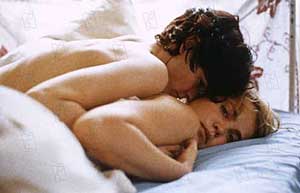 Despite
Syd's sudden attraction to Lucy, High Art
is not a coming out film. Other dynamics are at work and genders are actually
incidental. Syd doesn't show any signs of having been attracted to women
before. Maybe it's the heroin. Maybe the allure is cerebral, or perhaps
it's because her boyfriend thinks her job is frivolous and they are drifting
apart. Meanwhile James is also feeing threatened; he doesn't like it when
a few of the stoners in the upstairs apartment tell him that they didn't
know that Syd had a boyfriend, and another says that Syd is in the bedroom
with the hostess. When he finally confronts her, she doesn't know what
her feelings are for Lucy Berliner. Is she falling in love or is she
just trying to make sure that the procrastinating artist makes her press
deadline? Despite
Syd's sudden attraction to Lucy, High Art
is not a coming out film. Other dynamics are at work and genders are actually
incidental. Syd doesn't show any signs of having been attracted to women
before. Maybe it's the heroin. Maybe the allure is cerebral, or perhaps
it's because her boyfriend thinks her job is frivolous and they are drifting
apart. Meanwhile James is also feeing threatened; he doesn't like it when
a few of the stoners in the upstairs apartment tell him that they didn't
know that Syd had a boyfriend, and another says that Syd is in the bedroom
with the hostess. When he finally confronts her, she doesn't know what
her feelings are for Lucy Berliner. Is she falling in love or is she
just trying to make sure that the procrastinating artist makes her press
deadline? |
|
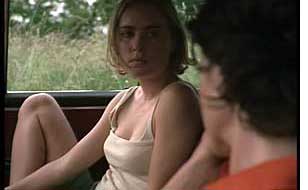 High
Art is
a terrific film about ambition in the arts. It is also a harrowing film
about heroin addiction, second perhaps only to Trainspotting in its
realism and intensity. Ally Sheedy sheds the bubbly cuteness that made her
famous in the Brat Pack movies of the 1980s; at times she looks almost cadaverous
and every bit the heroin user. She delivers a fascinating portrait of an
artist. Tired of the bullshit that accompanies fame, she explains that "it
seemed kinda punk at the time," when she left New York and stopped showing
her work. It's clear she wants it back but Greta is a problem and a major
distraction. How can you concentrate on your art, and who cares about the
looming deadline, when you girlfriend is overdosing on junk? High
Art is
a terrific film about ambition in the arts. It is also a harrowing film
about heroin addiction, second perhaps only to Trainspotting in its
realism and intensity. Ally Sheedy sheds the bubbly cuteness that made her
famous in the Brat Pack movies of the 1980s; at times she looks almost cadaverous
and every bit the heroin user. She delivers a fascinating portrait of an
artist. Tired of the bullshit that accompanies fame, she explains that "it
seemed kinda punk at the time," when she left New York and stopped showing
her work. It's clear she wants it back but Greta is a problem and a major
distraction. How can you concentrate on your art, and who cares about the
looming deadline, when you girlfriend is overdosing on junk? |
|
 Patricia
Clarkson functions almost as if she were a character in a Fassbinder
film and her performance as Greta induces chills. She is so burned out that
she sleepwalks through life, falling asleep in restaurants and even during
sex. It's creepy, and almost scary, how she always shifts the blame for
everything to her younger partner. A narcissist of the first order, she
insists that she was the one who made all the sacrifices by giving
up her life in Berlin to be with Lucy. She's a great comatose villainess
who also manages to inspire pity. "Greta, Fassbinder's dead," Lucy finally
says when she's reached her limit. "You didn't have a career after
that." Patricia
Clarkson functions almost as if she were a character in a Fassbinder
film and her performance as Greta induces chills. She is so burned out that
she sleepwalks through life, falling asleep in restaurants and even during
sex. It's creepy, and almost scary, how she always shifts the blame for
everything to her younger partner. A narcissist of the first order, she
insists that she was the one who made all the sacrifices by giving
up her life in Berlin to be with Lucy. She's a great comatose villainess
who also manages to inspire pity. "Greta, Fassbinder's dead," Lucy finally
says when she's reached her limit. "You didn't have a career after
that." |
|
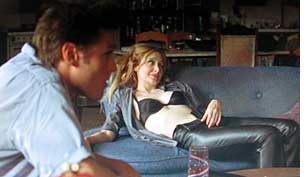 There
is much to admire in this film and its plot works on many different levels.
The growing sexual tension between the ladies is in the forefront but a
good deal of drama is also generated when it begins to look like Lucy is
blowing off the magazine. Syd is still being treated with condescension
by her editors and her job is on the line if Lucy fails to deliver. Some
of the scenes at the magazine are quite funny, especially the ones where
Harry pretends that he knows exactly who Lucy is when, in reality, he has
never heard of her. At times it almost seems as cut-throat as Wall Street
when Dominique reminds Lucy about how another famous photographer was supposed
to get the cover. Lucy gossips with Syd, in private, about how the
annoying Dominique was once the receptionist at Interview. There
is much to admire in this film and its plot works on many different levels.
The growing sexual tension between the ladies is in the forefront but a
good deal of drama is also generated when it begins to look like Lucy is
blowing off the magazine. Syd is still being treated with condescension
by her editors and her job is on the line if Lucy fails to deliver. Some
of the scenes at the magazine are quite funny, especially the ones where
Harry pretends that he knows exactly who Lucy is when, in reality, he has
never heard of her. At times it almost seems as cut-throat as Wall Street
when Dominique reminds Lucy about how another famous photographer was supposed
to get the cover. Lucy gossips with Syd, in private, about how the
annoying Dominique was once the receptionist at Interview.
|
|
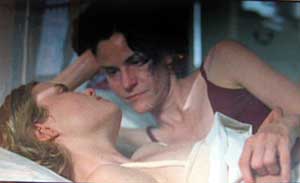 The
inevitable seduction is superbly realized and doesn't follow any standard
Hollywood "meet-cute" scenarios. Yes there is eye contact and subtle flirting,
but their first kiss is interrupted by their stoner friend, Arnie (Bill
Sage), barging in to announce that Greta has OD'ed in the bathroom. When
they go off on a road trip to take pictures, Syd (who had snorted her first
line of heroin back at the apartment the night they kissed) says she doesn't
want to get high this weekend. Lucy agrees as Syd explains, "I just don't
want to be with you like that right now." Syd is confused, and needs a clear
head. In one of the most exqusite love scenes with a nervous first-timer
ever filmed, Lucy is a confident, and older, teacher who asks "You okay?"
and "You sure?" Syd says she doesn't really know what she's doing and Lucy
says, "You're doing fine." Both the tenderness and the awkwardness
is beautifully conveyed. Much of this is captured in one long, expertly
acted and sensual camera shot with music that doesn't scream to be noticed.
Afterwards, Lucy begins to snap pictures of her new lover. The
inevitable seduction is superbly realized and doesn't follow any standard
Hollywood "meet-cute" scenarios. Yes there is eye contact and subtle flirting,
but their first kiss is interrupted by their stoner friend, Arnie (Bill
Sage), barging in to announce that Greta has OD'ed in the bathroom. When
they go off on a road trip to take pictures, Syd (who had snorted her first
line of heroin back at the apartment the night they kissed) says she doesn't
want to get high this weekend. Lucy agrees as Syd explains, "I just don't
want to be with you like that right now." Syd is confused, and needs a clear
head. In one of the most exqusite love scenes with a nervous first-timer
ever filmed, Lucy is a confident, and older, teacher who asks "You okay?"
and "You sure?" Syd says she doesn't really know what she's doing and Lucy
says, "You're doing fine." Both the tenderness and the awkwardness
is beautifully conveyed. Much of this is captured in one long, expertly
acted and sensual camera shot with music that doesn't scream to be noticed.
Afterwards, Lucy begins to snap pictures of her new lover. |
|
|
Lisa Cholodenko
also directed an episode of: Patricia Clarkson
also appears in Bill Sage also
appears in: |